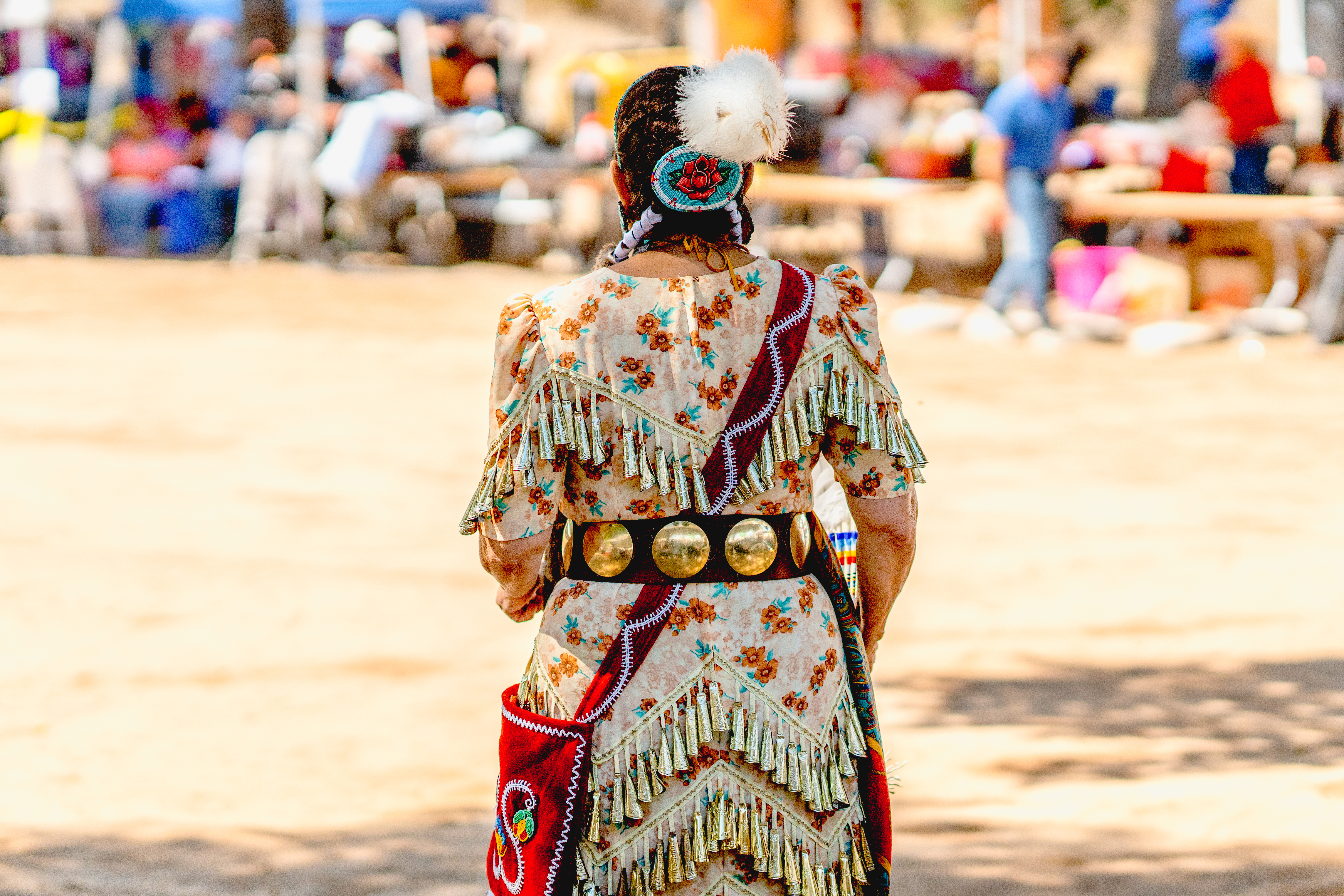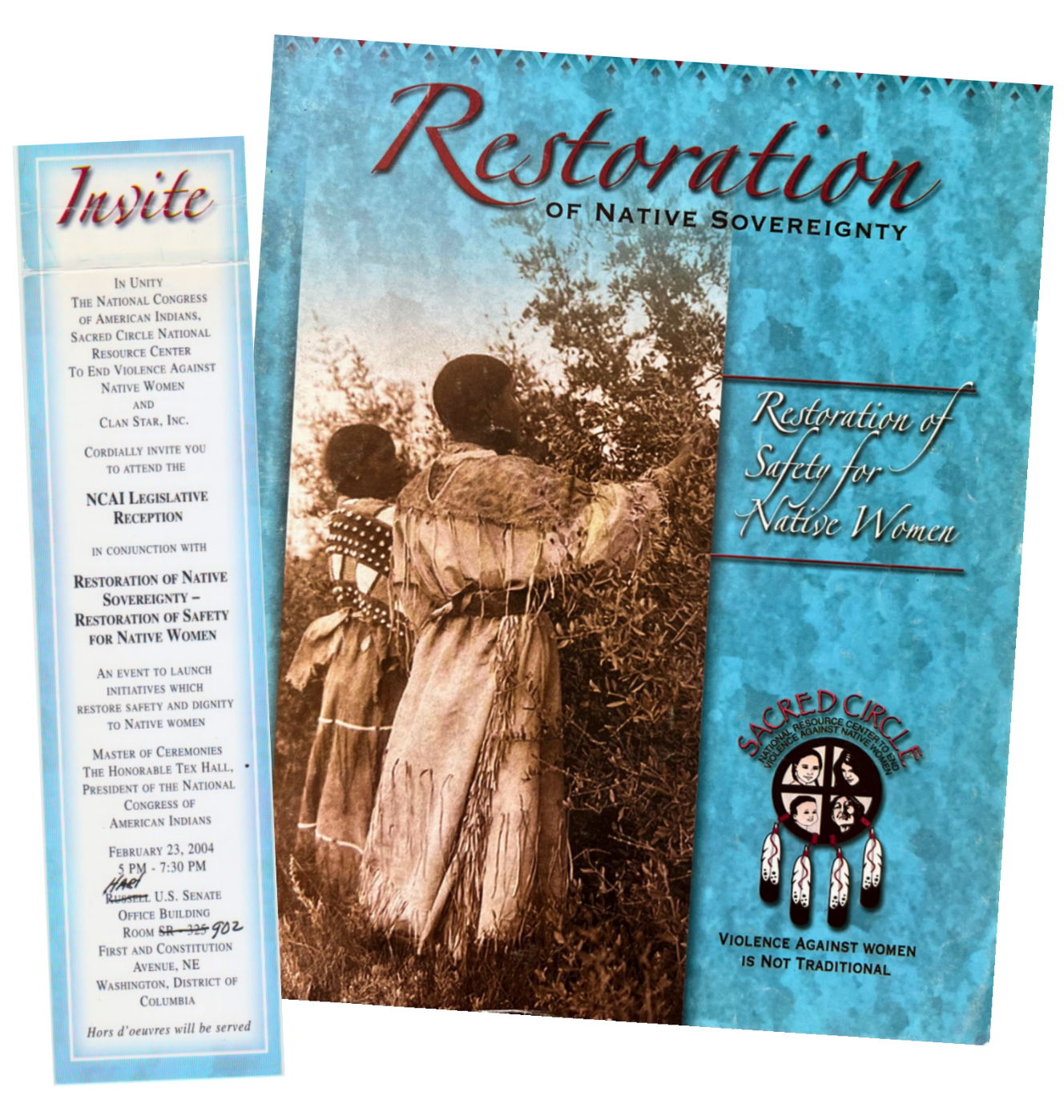Restoration of Native Sovereignty and Safety for Native Women
A Magazine Providing Analysis Toward Ending Violence Against Native Women

Restoration of Native Sovereignty and Safety for Native Women (Restoration) is a strategic political publication produced triannually by the National Indigenous Women’s Resource Center (NIWRC). The primary purpose of Restoration is to inform Tribal leadership and Native communities of emerging and ongoing issues impacting the safety of Native women and to provide the necessary political analysis to address such issues. Our underlying goal is to support social justice organizing to create change, including law and policy reforms needed to increase the safety of Native women.
How Restoration is Distinct: A Strategic Tribal Framework to Restore Safety
The guiding framework of the publication links the spectrum of violence committed against Native women to the historical pattern of violence used to diminish the sovereign authority of American Indian Nations to safeguard the lives of their women citizens. The name of the publication reflects the strategy of the grassroots movement, which asserts that by strengthening the sovereignty of Native Nations to hold perpetrators accountable, the safety of Native women will be restored.
The framework of Restoration is grounded in a Tribal or Indigenous worldview. We develop from the viewpoint of how violence, including barriers to the safety of Native women are experienced through the eyes of these very women; and how Native women and Native Tribes address the violence. In short, it’s by Native women for Native women. Moreover, proposed solutions, changes, and legal reforms are developed from a Tribal perspective of strengthening the support needed for Native women. This view is generally absent in reform efforts of the national movement to end violence against Native women, including federal departments charged with the “responsibility to assist tribal governments with safeguarding the lives of Indian women.”1
Development of Restoration

The first edition of Restoration was published on February 23, 2004, at a historic moment in the national movement for the safety of Native women. In February 2004, Sacred Circle partnered with the National Congress of American Indians (NCAI) to organize a legislative reception at the U.S. Senate Hart Building in Washington, D.C. The event focused national attention on violence against Native women and the importance of the proposed Tribal Title to the 2005 Violence Against Women Act (VAWA) reauthorization. Restoration provided the analysis and urgency of inclusion of the Tribal Title. In addition, Tillie Black Bear led a Wiping of the Tears Ceremony for the several hundred attendees to center Indigenous beliefs and the context of spirituality.
Several national Tribal organizations united to pass the Tribal Title of VAWA 2005, the Safety for Indian Women title. A primary barrier to the passage of the title was the need for a shared understanding of the legal obstacles embedded in the legal infrastructure of the United States. These legal and policy obstacles continue to function as an extension of the colonization of Indian Nations by the United States.
To support passage of the VAWA 2005 Tribal Title, the Sacred Circle National Resource Center, Clan Star, Inc., NCAI VAW Task Force, and non-Native organizations recognized that for Tribal leaders and grassroots advocates to participate in the national movement to enact the Safety for Indian Women title, they would need ongoing briefings about the amendments. Further, advocates and Tribal leaders required detailed analyses of how the barriers embedded in federal Indian law made Native women vulnerable to violence in their daily lives.
Restoration was intended to inform and connect the spectrum of violence committed against Native women to the history and federal laws and policies that destroyed the traditional social protections that historically existed for women within their Tribes for centuries. In 2003, this public policy organizing and its connection to individual advocacy for women were new to the developing national movement. Still, they needed to be elevated because Tribal advocacy programs as they exist today were few and far between and operated on shoestring budgets. For the first time, the movement had access to new resources available, such as Restoration and resources under VAWA 1995 and 2000. The movement began emerging in the early 1970s and 1980s when advocates used to sleep in cars or share a room to attend meetings addressing violence against women.
The Sacred Circle National Resource Center recognized the importance of NCAI’s legislative efforts and consulting with Tribal leaders since legislative amendments impact all Indian Tribes. The National Task Force to End Domestic and Sexual Violence Against Women (NTF) was a strong supporter, and Restoration included its logo for many years. In 2003, the national Tribal movement lacked a strong national relationship with congressional champions of VAWA, which made support from the non-Native allies extremely helpful. Less than a dozen Tribal coalitions existed since the Office on Violence against Women (OVW) Tribal Coalitions program was created in VAWA 2000 and launched in 2001. VAWA 1995 contained a 4% Tribal government set aside; VAWA 2000 increased it to 5%, and VAWA 2005 increased the Tribal government set aside to the current 10%.
Due to the advocacy of Native women, such as Tillie Black Bear, the current movement emerged. While rising to support many broader related attacks on Indian Tribes, this Tribal framework has guided the movement to focus on specific advocacy for the safety of Native women. “Who is going to advocate for the safety of Native women if not us?”—Tillie Black Bear. Restoration has maintained this Tribal framework, strategy, and organizing for action for nearly two decades.
Supporting the National Movement for Safety of Native Women, 2003 - 2023
Restoration has consistently supported the growth of a national social justice movement for the safety of Native women. Restoration was published twice annually from 2003 – 2010 and three times per year from 2011 to the present. It primarily informs about essential Tribal legislative reform efforts, emerging issues, and updates, including attacks on Tribal sovereignty. Examples of these organizing efforts include:
-
2004–2005 Communication regarding the inclusion of Title IX, the Safety for Indian Women title within the VAWA 2005 reauthorization and implementation of the new Tribal provisions, including the mandatory government-to-government consultation and the national program of research.
-
2007-2008 Communication regarding the attacks on Indian Tribes under the Adam Walsh Child Protection and Safety Act of 2006; communication regarding implementation of VAWA 2005; preparation for annual consultation; support for the Tribal Law and Order Act (TLOA) amending ICRA to increase Tribal sentencing up to 3 years and creation of the Indian Law and Order Commission. First national coverage of MMIW regarding the disappearance and murder of Victoria Eagleman on the Lower Brule Indian Reservation.
-
2009-2010 Communication regarding the delayed VAWA 2011 reauthorization until 2013 due to opposition to the Tribal provisions; FVPSA 2009 reauthorization; TLOA passage; amending the Adam Walsh Act; MMIW; first amicus brief filed before the Inter-American Commission on Human Rights.
-
2011-present Legislative updates regarding reauthorization and implementation of VAWA 2013 and 2022 Tribal amendments, reauthorization of the Family Violence Prevention and Services Act 2010, passage of the Victims of Crime Act Tribal funding stream; MMIW organizing efforts; U.S. Supreme Court monitoring and filing of NIWRC amicus briefs; and international updates.
Engaging in Dialogue: Understanding and Context
The priority of distribution of Restoration is focused on the national movement leadership, including advocates and Tribal leadership committed to addressing the safety of Native women. The target points for distribution include the Women Are Sacred Conferences, Tribal leaders during each NCAI Violence Against Women Task Force meeting and NCAI Annual Convention meetings (3 times annually), regional meetings, such as the Alaska Federation of Natives (AFN), annual government-to-government consultations sponsored by the United States Department of Justice (USDOJ) and the Department of Health and Human Services (DHHS), academic programs, national conferences, federal policymakers, and other events based on the emerging national issues and priorities of NIWRC. Restoration also plays an essential role in the dialogue with national lawmakers, their staff, and federal agencies to secure changes required to increase the safety of Native women.
General support to end violence against Native women is essential, but support based on a clear understanding of the foundation of the violence, barrier by barrier, is essential. Creating joint action requires engaging in discussion to develop an understanding of the “why” of the direction forward. Restoration is a valuable asset for the movement to organize these critical conversations from an Indigenous perspective and context.
1 Title IX. Safety for Indian Women Act, VAWA 2005. Finding #6.





